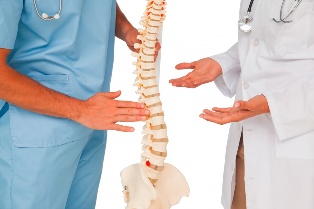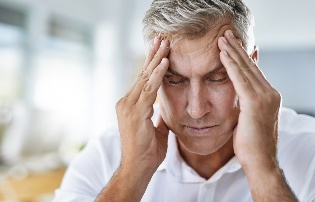
Many people associate the word "osteochondrosis" with old age. It is a disease of a grandmother and grandfather with "shoots in the back" and "back pain. "However, there is only one truth in this dream: indeed, osteochondrosisdegenerative(ie caused by a local metabolic disorder)changes in the spine, inevitably appear in all older people. However, osteochondrosis is now found in 9 out of 10 people over the age of 45, and the first manifestations of the disease can begin at age 25.
Because the main cause of osteochondrosis is the misuse of the spine, this disease is called"disease of civilization. The truth is that a modern man puts him under extreme loads and, paradoxically, not when running or lifting weights, but when he sits for hours without getting up from a chair. This load is calledstaticand is very cunning. Because a person thinks that he is resting while sitting. But in reality, a sedentary back works with increasing stress.
How the spine works
To understand what osteochondrosis is, you need to understand what the human spine is. We all know that the spine consists of intervertebral discs and interconnected vertebrae. In general, a person has a total of 33-34 vertebrae: 7 of them are the cervical region, 12 are the thoracic region, 5 (or 6 in a small group of people) are the lumbar region, and 5 more vertebrae grow together to form the sacrum, and finally the coccygeal. region is formed. the other five (or four - vertebrae - depending on individual characteristics). The vertebrae are actually bones and immobile, but they provide the mobility of our entire body to be able to move freely, and there is a layer of gelatin between each vertebrae so that they do not collapse from impact and friction (so-called). nuclear pulposus) is surrounded by strong multilayered plates (annulus fibrosus). Collectively, this is called theintervertebral disc.In addition, there are many ligaments, veins and nerves in the spinal structure. Because it protects and affects the spinal cord, it is a very complex organ that largely determines the functioning of almost all body systems.

Vertebrae and intervertebral discs are constantly updated throughout a person's life. This is possible because they are well supplied with blood and are always provided with good nutrition. However, if for some reason nutrition begins to flow sufficiently to the spinal column, the pulposus nucleus loses its properties, the intervertebral disc becomes flattened and less elastic, cracks form in the annular fibrosis, and the vertebrae themselves begin to change in different directions and approach each other. All this leads to a number of dangerous deviations - in the first placeInflammation both in the spine itself and in the surrounding tissues, to the point of compression of the spinal cord and spinal nerves.
Interestingly, a concept such as "spinal osteochondrosis" exists mainly in the post-Soviet space. In the foreign literature, changes in the thorns are called"hernia", "myofascial pain", "disc injury", "dorsopathy". So, if you have heard something similar about yourself, you have osteochondrosis of the spine. As forintervertebral hernia, it is considered one of the stages of osteochondrosis.
The disease is not acute and develops gradually: first the intervertebral disc narrows, degenerates, thenprotrusions appear- the pulposus nucleus is compressed and mixed with the fibrous ring, but does not break it. When there is a rupture of the annulus fibrosis,talk about an intervertebral hernia.In the last, most severe stage of osteochondrosis, theintervertebral discs wear out completely, the vertebrae begin to rub against each other, and pathological bone growths and osteophytes form. In the final stage, the spine becomes "petrified", ie it loses mobility, which can lead to disability.
Causes of spinal diseases
What causes all of the abovedegenerative changes?As mentioned earlier, the main cause isan abnormal load on the spine:For example, when a person is forced to sit too much in a restless position, in a "bent" position, the cervical and thoracic regions experience tension and need. does not take the ones. nutrition. In addition,osteochondrosis can develop due to poor posture.However,sports, especially strength sports, can lead to degenerative changes in the spine.
Another common cause is anyback injury. The development of osteochondrosis can be influenced by hereditary genetic predispositions, hormonal disorders, overweight, unhealthy diet, insufficient water intake and, as a result, dehydration, smoking and alcohol.
Women often experience the first manifestations of osteochondrosis during pregnancy, and then the condition of the spine deteriorates significantly when young mothers are forced to feed their babies in an uncomfortable position and often carry them in their arms.
Symptoms of Osteochondrosis
The symptoms of osteochondrosis are different and depend on the exact department in which the disorder occurs. Pain is the main manifestation of this pathology, however, it is as weak as the rupture of the ring fibrosis, can be tiring and painful, and patients do not pay attention to it.More often the pain intensifies in the morning or after physical exertion, spreading to the arms, legs, neck, ribs and chest (in this case, osteochondrosis can easily be confused with coronary heart disease).
In addition,muscles may appear numb and tingling.
Osteochondrosis of the neck withheadache, sometimes very severe, may appear as dizziness, nausea, whistling in the ears. The development of a hernia, which causes the nerve endings to constrict, can lead to dysfunction of the internal organs associated with the affected nerve. For example, a hernia of the spine can cause problems with urination, the potential disappears, in the chest - indigestion, in the cervix - problems with the blood supply to the brain.

Diagnosis of osteochondrosis
Only a doctor can distinguish osteochondrosis from other diseases of the internal organs and determine the source of pain. Today, the most reliable method for the diagnosis of spinal diseases is magnetic resonance imaging.
X-rays are also reliable, but less informative. You can see changes in the intervertebral discs on an X-ray, but you can't see, for example, a hernia, and you can't assess the condition of the spinal cord and the degree of compression with the displaced spine. In addition, MRI allows to distinguish osteochondrosis from other dangerous diseases, including malignant tumors and Bechterew's disease.
Is it possible to treat osteochondrosis?
Unfortunately, there is no cure for osteochondrosis, but it is possible to alleviate the patient's condition and stop further destruction of the intervertebral disc, but it is possible to completely change the lifestyle - physical therapy, swimming, regularas you need to take courses. massage or manual treatment, start eating properly and give up bad habits. Exercise, massage, proper nutrition and weight loss can have a significantly greater and longer-lasting healing effect than medications.
Doctors are still debating the effectiveness of chondroprotectors - drugs that restore cartilage tissue and strengthen ring fibrosis, the effectiveness of which has not been sufficiently proven, but can be used in the treatment of osteochondrosis because they do not cause definitive damage.
For severe pain, your doctor may prescribe non-steroidal anti-inflammatory drugs (NSAIDs), muscle relaxants (analgesics) and analgesics.
Vitamins are used in the treatment of osteochondrosis andbecause their deficiency leads to further destruction of the intervertebral disc:B vitamins, for example, help to improve protein metabolism between tissues. Protein is the main building material in the body, the normalization of protein metabolism helps to restore nerve and cartilage tissue. Vitamin A improves blood circulation. However, taking vitamins, like other medications, you should be careful, because they can cause serious adverse reactions, and they can be taken only after consulting a doctor and under his supervision.
Surgical treatment of osteochondrosis is also possible, but is usually used when there is a significant narrowing of the spinal canal and excessive compression of the nerves and spinal cord by the resulting hernias. In this situation, the situation is so difficult that the patient, for example, can not walk, begins to malfunction of internal organs, or is at risk of paralysis. Often such serious consequences from cervical and lumbar osteochondrosis, degenerative changes in the thoracic spine, even in the presence of a hernia, almost never require surgical treatment.
Today, when doctors are able to use aendoscopeto remove part of the pulposus nucleus and preserve the integral structure of the vertebrae, methods calledso-called surgeryare actively used in medical practice. The device is placed in the area of the spinal lesion through small incisions in the skin, which avoids large blood loss. Because not all discs are removed during surgery, spinal biomechanics are generally not a concern, and this shortens the recovery time. Patients often get up the day after surgery. However, any spinal surgery is still fraught with complications and subsequent relapses of the disease, so experienced professionals will try to delay surgical treatment until the end. And here everything depends on the patients themselves: if they follow all the recommendations of doctors and take care of their health, they can do it without surgery, even if there is a hernia.

















































